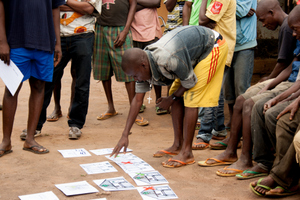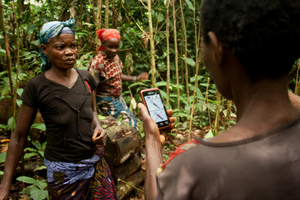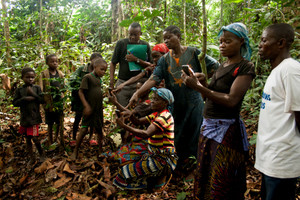
As I write this blog update I am sat at a junction on the forest road, where the Moabi project field team and I (see my previous blog post for details) are staying in a hotel, of sorts, in Equateur province, Democratic Republic of the Congo (DRC). The facilities are basic but comfortable – we have beds and nets, the proprietress and her family are excellent cooks and I’ve always had a fondness for “showering” using a bucket beneath the stars. It’s been an interesting week, full of lessons for everyone involved – not least the field team I have been training in the ExCiteS approach and the Tswa Pygmy community with whom we’ve been working to adapt a Sapelli decision tree, but most of all for myself, both as trainer and as anthropologist, in the great complexities of conducting participatory work in one of the final frontiers of the modern world.
I should probably start by making clear that although the forest feels very similar (in fact, we’re not a very long way the other side of the Congo River from ExCiteS’ pilot fieldsites in Congo-Brazzaville), its inhabitants are descended from the same ancestral populations and Lingala is still the trade tongue in the remote areas where I’ve been travelling, the situation here is quite different to that the ExCiteS team encountered in DRC’s neighbour. Here the government is yet to reach any agreement over FLEGT, the country’s forest code remains incredibly weak with regards to land tenure and use rights for forest people, and no national laws exist for the promotion and protection of indigenous rights. In addition, the long history of armed conflict in DRC has decimated what infrastructure once existed, and the forest-dwelling people of Equateur province live far from the reach of state influence (as do international industries conducting extractive activities).

The Tswa village we have been working with sits inside the logging concession of a Lebanese firm. Relations between the company and the population are poor – although local people are still able to access the forest to hunt and gather food, the company has cut down many of the caterpillar trees on which the Tswa are dependent in the dry months when there is little else to eat. In addition, while there has been some limited consultation with local people, the Tswa we worked with claimed that the company had kept none of their promises (eg. to help with school fees for their children), and that the community does not benefit at all from the exploitation taking place in their forest. The Pygmy population here is sedentarised to a much greater extent than those we worked with in Congo-Brazzaville – the Tswa village is comparatively huge (the population numbers in the hundreds) and people rarely live in the forest proper for long periods any more. As such, they are finding hunting more and more difficult – the forest animals have all fled the area, particularly since people have begun hunting with dogs and commercial poachers have started to move in. The result is a large population struggling to find enough to eat, and angry in the knowledge that their forest is being exploited for commercial gains they will likely never share.
While such an environment is potentially fertile ground for participatory mapping and monitoring work, it is also highly complex. As throughout the Congo Basin region, the Tswa communities live alongside Bantu populations, and the relationship between the two is one of intense discrimination and oppression. In addition, this is one of the most accessible regions of DRC – at just one hour by air (plus a good 3-4 hours faffing around in the airport at either end) and five hours by road from Kinshasa, the Tswa villages in this region seem to be a favourite site for NGO pilot projects (over the last year they have seen teams visit from the UNDP, USAID and African Model Forests) – understandably there are signs of fatigue with such short-term engagements and it is clear that NGO projects are largely seen as a quick way to access cash rather than an opportunity for any sort of beneficial collaboration. Working through local, Pygmy-run, civil society organisations (CSOs) lends further complications – while clearly essential for their knowledge of local traditions and conditions, and for establishing a strong relationship with local people, such engagements add a further layer of power relations to navigate, and can introduce organisational cultures that may be mis-aligned with those of their international partners.

However, although we had only a fairly small amount of time to work with local people, their reaction to the ExCiteS tools, and to the prospective benefits of participatory mapping, was encouraging. We worked in three teams – two teams of men and one of women – and my colleagues were satisfied both that people were able to manipulate the software well and that the forest monitoring and mapping decision tree created during the training week in Kisantu was largely relevant (although there are still many suggestions to incorporate). Indeed, OGF intends to bring the data we collected concerning the community’s issues to the attention of the concession holder and will report back to the Tswa on the company’s reaction. The women I worked with were very keen both to demonstrate in photos what different kinds of resources were used for, and that we should add icons for other types of resource that are very important for their daily activities (mongongo leaves, honey and edible ants for example). They told me they felt the software was very well adapted for them, and they were curious as to whether they would be able to have a record of the points they had mapped – a good sign that ExCiteS’ work developing a GIS tool for non-literate people (Sapelli Maps) is likely to be appreciated. Most importantly for me, they said that if we were to return then they would give us a very good welcome, as unlike other NGOs they were very happy with the way we had worked with them so closely.
Of course, in such a limited period of field time it is impossible to gauge with any certainty what might become of a long-term engagement and there are still many questions left unanswered.

From what I have seen there is much promise for using ExCiteS methods and tools to assist in the work of the independent forest monitor in DRC, and to help local communities provide vital geographical data on their use of forest resources that could positively inform everything from the development of logging company management plans to the implementation of REDD+ projects. However such a project would face many challenges, from the lack of support for such participatory mapping and monitoring work in the country’s weak legal framework to the time and financial costs of working in such remote and inaccessible locations. Yet I hope that, now that this training has provided a taste of the possibilities to my local and international colleagues, we will find ways to open up new opportunities and continue collaborating, innovating and sharing within and among our different approaches, methods and goals.

2 Comments